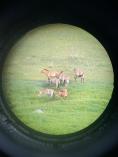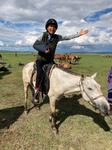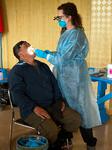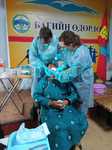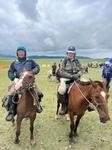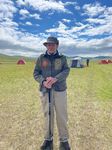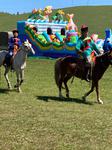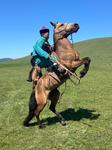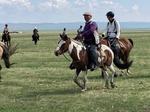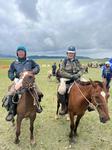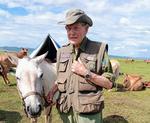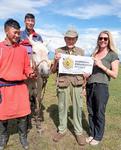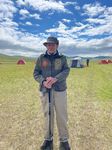
Khan Khentii Mongolia, 2023
Four years ago we had planned an expedition to the Khan Khentii area of Eastern Mongolia. Alas, the pandemic and more recently the Ukrainian war forced us to postpone the venture. However, at the end of June this year it finally took place with a team of twenty-six intrepid individuals from six nations. The project was supported by the Scientific Exploration Society and moved in vehicles and on horseback.
Our tasks involved studies of the wild Przewalski horses, and in cooperation with the National University archaeological, botanical and zoological research. At the same time we gave medical and dental support to the local people, and provided books to local schools.
In the Hustai National Park we counted over 40 Przewalski horses, all in a good condition and many of the mares with healthy foals. We also saw 74 marmots (known to carry the flea that is host to Bubonic plague) and our camera traps recorded many Red Deer and a number of wolves.
Box traps and cameras helped us to study smaller mammals including Ground Squirrels, Siberian Chipmunks, Red Fox and of special interest to me, a Tundra Vole and Hamsters (I remember my daughter’s pet one that escaped and ate through our electric cables at home!)
Together with a Mongolian ornithologist we recorded rare birds including Swan Geese, Baikal Teal, Pochards, Horned Grebe, Bearded and Cinereous Vultures, many species of Crane, Northern Lapwing and both Bar-tailed and Black-tailed Godwits.
The botanists studied medicinal plants, whose spread has been affected by unfavourable weather and the growth of livestock, and we catalogued over a hundred species of plants and recorded their spread. Dried specimens were brought back for further study at the university.
British and Mongolian archaeologists studied Bronze Age tombs and “Deer Stones” , decorated with extraordinary carvings. Rock art dating back 30,000 years depicted men and animals, including rhinoceros were found and an ancient stone slab showed carvings of inhabitants dancing and a man engaged in sex! Two rare, green-coloured stone tools were also discovered.
Our medical team gave much appreciated advice to the local people and our dentist carried out fifty-two extractions and gave fluoride treatment to twenty-seven patients as well as carrying out oral cancer screening. Wool finger puppets made by a group of ladies in southern Dorset were given to children who had teeth removed. As usual, some said “please take out my tooth I want a puppet”.
Most of us returned fit and well but we had two casualties. One broke ribs when falling from his horse and another injured her wrist on a tumble when on a zoological quest. They received excellent treatment by our doctors and both are now home and recovering.
Unusually heavy rain made the cross-country journeys challenging, and our vehicles had to be pulled out of mud on several occasions. At one flooded river the drivers of our support trucks, old Russian Army 4 tonners, decided to avoid a damaged bridge and fearlessly drove into the torrent. Both got stuck in water four-feet deep and the engines died. However, a local horseman rode into the river carrying a rope to them and with this we pulled their winch cables to the bank, from which our four-wheel drive cars could haul them out.
We also attended a local Naadam Festival where colourful horse racing, wrestling and archery were practiced in an annual ceremony.
In between some spectacular thunderstorms that swept across the open steppes, we held our traditional Burns supper (regardless of the date) and downed Stahly’s haggis from Scotland and a few drams in the moonlight.
It proved to be a most successful expedition well enjoyed by our international team and appreciated by our Mongolian hosts, led by Prof Terbish of Great Genghis Expeditions, Ulaan Baatar.
SITREP 1 28th June
Almost all team now in Ulaan Baatar. Last one expected on 30 June.Many flights delayed . Due to change of Nadaam date we shall carry out Prezwalski horse study at Khustain reserve first before moving to Khan Khentii on 3 July. Three of us attended king’s birthday garden party organised by British Embassy today. Weather fine and warm. ENDS.
SITREP 2 5th July.
Completed studies at Hustain on 3rd July. Sighted over 25 prezwalski horses, 18 red deer, 2 wolves, 74 marmots and a hare.
Gerbils and voles also collected and released.
Botanical and archaeological tasks carried out. Great success with camera traps. Journey to khan Khentii delayed by heavy rain and mud. Stopped for night in BnB at small town. One vehicle broke down but now repaired and has rejoined us. Presented books to Umnudelger school. pupils welcomed us with horse head fiddle recital.
Now camped 8 kms from Baldan Bereeven temple. Rode on our horses there today. To see this famous cultural centre. Rain showers continue with some sunshine. Ends
SITREP 3 9th July.
Our zoologist Dr Shar has collected a Tundra Vole, which excited us. In last 2 days we have covered over 60kms on horse back and we are now camped at Binder ovoo, An area noted for wildlife. Our Botanists continue to study medicinal plants and also came across a Halyers viper, one of the few venomous snakes in Mongolia. Gabriella Welsh and Jack Fisher are using their drones to photograph the archaeological sites.
Emily Waldman, our dentist has already treated over 20 local people and plans another clinic on 11th July.
Books are being given to local schools.
The weather has improved but there are still heavy showers. Ends
SITREP 4, 16TH JULY
Having completed all tasks in Khan Khentii area the expedition is now returning to Ulaanbaatar.
The Nadaam festival we visited at Batshirreet was most enjoyable and entertaining. Throughout the work our teams rode 190 kms on local horses. A Burns supper was held on 14th july as is the tradition
on our expedition. On 16th July we shall be guests at a farewell dinner given by our agents Great Ghenghis expeditions at the Silk Road restaurant. On the 17th july the team will start to disperse
after a most successful expedition. Ends.







